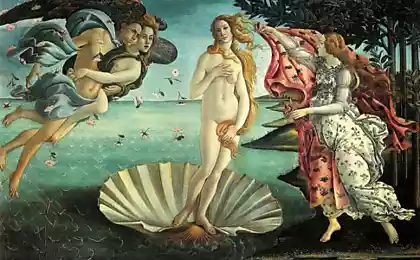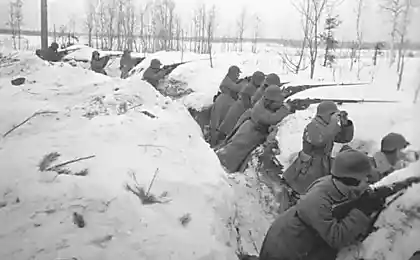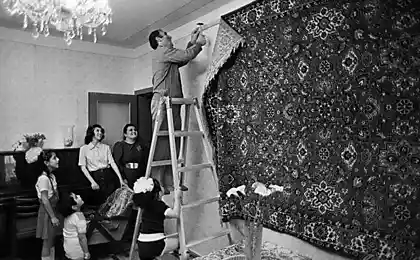736
Objects of the cult of the Soviet era
Ten things at different times of the USSR is an object of worship.
This article attempts to look over the Soviet and post-Soviet period of Russian history and choose the things that at one time had the greatest impact on life, worldview, health and other aspects of the lives of ordinary people.
Will the desire - add!

1. PRIMUS:
"And set fire to me, Arivederchi ...»
The Soviet people adored hiking.
Almost every second family just could not imagine vacation without kayaking, skiing, or at worst only the heavy backpack. And the most essential thing in the campaign - the primus.
Such an modified kerosene stove, on which you can boil tea, and fish fry. The most popular series was considered "Bumblebee" in various versions.
However, there is a version that the Primus was developed by Soviet scientists during the "cold war" as a weapon of mass destruction. In support of this assertion evidenced, for example, the movie "The Rock", in which the villains are thrown into the sewers some gizmo, painfully reminiscent of the native "Bumblebee-2", with the words: "Well, grohnet same now!" And indeed crashed - a little not shown.
Joking aside, but it was the primus, for example, the cause of death of the famous Hotel Elbrus "Shelter eleven."
Drunk Hungarian guest tried to pour fuel into the burning unit, and a few hours from the lodge was only a skeleton.
So our "Bumblebee" has earned a reputation Herostratian.
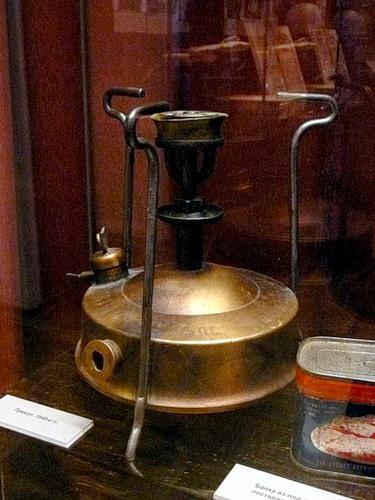
2. Boilers:
"Otvoari sly gate ...»
A relative of my friend in some hairy years went on trips abroad.
As his delegation had official and very high, all housed in a five-star London hotel. And in the evening after dinner, Russian delegate occurred to cook soup. Right in the room. From the bag, brought from the motherland. Without hesitation, comrade went tested by: went to the bathroom, poured into a sink of water, uncovered favorite boiler and put the plug into the socket. In the same second half of the pathos of the hotel remained without electricity: gourmet jams could not stand the pressure of the Soviet kilowatt unit.
Security sheikh stood on the ears, ran officers' Oh, I'm sorry for the inconvenience, do not even know how this could happen ... "In general, all the victims, including the perpetrators of the tragedy spread through other numbers. And for the hotel staff remained a mystery what happened with the proven power supply system.
And all because they did not know one simple truth: no Soviet citizen travels outside his city without a personal boiler.

3. "Spidola»:
"The enemy is on the line.»
Baltic States has always stood out among the republics of the USSR anti-communist sentiment polls. It was known to all.
But no one could have predicted that Lithuania will throw a big brother in the form of a pig "Spīdola."
The first Soviet portable transistor radio was made in 1961 at the Riga factory "WEF". And instantly became a cult object.
At relative compactness (not by today's standards, of course), he had a remarkable ability to catch waves. That is - the enemy's voice, "Voice of America", "Radio Liberty", "Deutsche Welle", etc. Suffice it to recall that in the epic "The fate of the resident" the main character - an American spy - namely with "Spīdola" takes encrypt their overseas owners.
Simple as Soviet people just getting infernal pleasure of listening to the restricted information through gebeshnye jammers.
So "Spidola" made a contribution to the destruction of the USSR. Legendary receiver is actually all products "VEF", turned out to be remarkably tenacious: my "Spidola," for example, is still regularly serves the country.
By the way, if someone does not know: the word "Spidola" to do the accent on the first syllable, not the second, as we have decided.
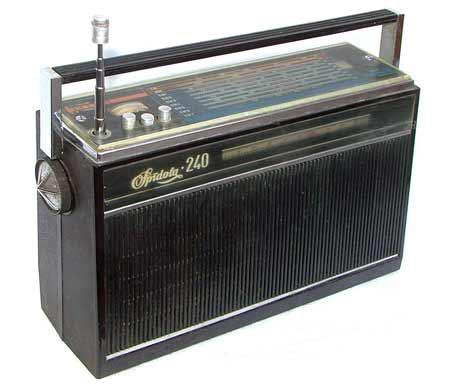
4. "Ribs»:
"The sound of bones do not ache.»
They say there was a time when the CD is not met even in science fiction stories.
Yugoslav vinyl too, it was not yet in sight.
But was Elvis Presley.
And everyone wanted to listen to him, but few could do it because of the terrible shortage of his records in the USSR. But necessity is the mother, as you know, the mother of invention.
Craftsmen whose names history, unfortunately not preserved, realized that conventional X-rays very well be used as a sound carrier. In film sound went the same way as a flexible phonograph.
Of course there were some inconveniences.
First, the sound extracted from such specific records, to put it mildly, different from the original - and not in a good way.
Secondly, a few confused design: a music library from another, pitted cirrhosis and Broken limbs - that, you know, a dubious pleasure. Nevertheless, the "edges" as popularly called rentgenplastinki, enjoyed great popularity, which is not surprising: the choice actually was not.
Snapshot recording disappeared only after release of the first reel to reel tape recorders.
But all the same, "the edges" made history as the Soviet symbol of the love of bourgeois culture.
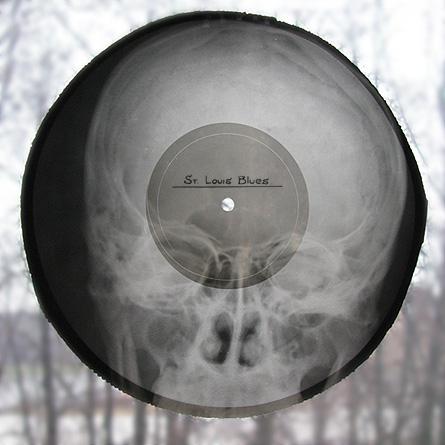
5. "Varenko»:
"Denim soup.»
The heyday of perestroika took place in Russia under the banner of "Varenkov" as well as democracy prevails today under the tracksuits.
Why should fashion bleached jeans so tight puzzled our citizens - is unclear. We see too got all the ubiquitous trousers Avis, resembling the color of the school uniform. Very much wanted something festive and bright.
The technological process of the so-called "Varenkov" something like this: wet jeans while rubbed through several layers of hot rocks. As a result of the fact that until recently proudly called his pants, turned into a rag spotted indeterminate color.
And that, in the words of modern teenagers would have been cool.
First orient the private sector is still young.
In an instant, all the lumps were packed self-made jeans, jackets, shirts and caps fashionable colors.
One of our famous couturier even boasted recently that started her modeling career at "Varenkov." In it, darling, dressed schoolchildren, pensioners, engineers and racketeers.
Who does not have enough money for cooperative jeans, trying to make them at home. Someone frenziedly tore off with the same "Avis" paint "indigo" with pumice, some days cooked in boiling water pants (where, in fact, the generic name).
The fashion for "Varenko" stood firm for several years.
And now a no-no, but I run into the subway in some geezer, dressed in a work of domestic postmodernism.
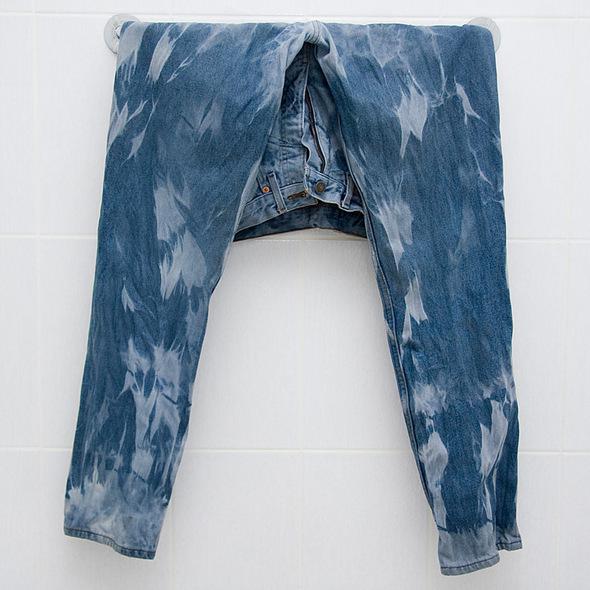
"6. TV "KVN":
Home cinema. »
"In twenty years there will be no cinema, no theater, no books - only one television" - considered the hero of the film "Moscow Does Not Believe in Tears".
He, however, turned out to be a hero by definition negative and had to get a finger to the sky. But then, in the 50s, the first appearance of the Soviet Union certainly has guided many of the TV is on such thoughts.
Home theater, however, was far from perfect. For the small screen adjusts hefty magnifier to make the image more or less visible to the eye.
But the first "KVNy" caused, to put it mildly, a furor. Owning this miracle at first considered a sign of a relationship with a member of the Politburo, the highest recognition of any services to the Soviet government.
If this turned out to be a TV miraculously in a communal life happy owners turned into a living hell.
Every night they had to take a man forty neighbors, eager to enjoy some television program - and it does not matter what.
Today the idea of television has lost its appeal.
"KVN" was one of the symbols of familiarizing people's civilization.

7. GLUE "BF»:
"Do not glue and drink.»
This product is known for the fact that in recent history has been preserved evidence of its intended use.
No one can say exactly what they should be glued. Because "BF" is used quite differently.
His drinking.
That is, of course, not the glue, and what was left after special treatment.
Technology of preparation of alcoholic drinks from the highly technical to the liquid was simple madness. In a bottle of glue inserted electric and cut in the maximum speed. As a result, after a certain time all the adhesive basis is wound on a drill, and the liquid remained in the vessel.
Which could only be filtered to produce a relatively pure alcohol.
However, when the liquor store the day the fire will not find - there can be no purity. The highest popularity of "BP" reached, of course, during the "dry law».
They say that the audience is literally drinking on duty at hozmage, waiting will bring another batch of glue.
So "BF" became the first Soviet legalize drugs. 8. checks in "Birch:
"Vanity Fair. & Quot;
In one of the stories Dovlatov black marketeer Tallinn said about his henchman, saying that it will come with a hundred dollars in the store and take it immediately, because it is written on his face that he was not like a hundred dollars - three rubles spawn in the hands of I held.
Dollars in the Soviet Union did not go. Their role is performed by the so-called checks - equivalent to that exchange currency imported into the country.
Otovaritsya checks could only spetsmagazinah with the symbolic name "Birch".
Theoretically outfit in "Birch" could only foreigners and citizens save on foreign trips daily in. However, in practice checks could buy at a reasonable price anyone.
However, the proposal greatly exceeded demand. By "berezochnym" prices VCR - the ultimate dream of the average citizen - it costs about three thousand rubles at the salary of the chief engineer 300 p. per month.
So the bulk of the workers went to the foreign exchange shops only out of curiosity - to take a look at the stacks of canned Coca-Cola and refrigerators' Rosenlew. "
Legalization currency put "Birch" ending.
But the checks have remained a symbol of Soviet privilege.

9. ALCOHOL «Royal»:
"Hangover is not.»
If you are not familiar with this name - you are either too young or you're a staunch teetotaler.
Mean capitalists took us by surprise. It was the height of the economic reforms. Drink in the stores was terribly expensive, but the money was not enough at all.
And then he appeared.
As in the joke about the Red Army, which wiped with alcohol tank first signs of the formula, while others have tried and realized he really.
He was in a tempting green bottles.
And most importantly - when mixed with water 40-degree solution became cheaper domestic vodka three times.
Taste, of course, leaves much to be desired, but we were there to get used to - after the "BFA" - that! Dutch alcohol "Royal" was the more popular of the commercially available products, including butter and brown bread.
Vodka bought only snickering cooperators who was too lazy to mix alcohol with water. What he was drunk - do not tell anybody.
End crept unnoticed.
Suddenly it became clear that from the "Royal" people massively go blind due to an abundance of liquid methanol. People's solution became hopelessly withdraw from the sale.
Soon, the "Royal" has disappeared altogether. But the memory of it alive.
At least, I recently saw a familiar bottle on one retail market.
No way, hard times are coming ...
10. kirzachah:
"Spanish boot.»
Until 1917 boots were made in Russia only from the skin, and the word "tarpaulin" according to Dahl designated strain doors from dampness.
But the revolutionary government has recognized the luxury for the soldiers of the Red Army unprecedented extravagance.
Boots canvas upper (according to the TSB, is "tight, robust multilayer cotton fabric, produced from fine-spun yarns, treated with film-forming substance is used as a substitute for the skin") became a part of military uniforms in the 30s.
The find proved to be successful for the government.
For the poor it was finally found a replacement rounders, and that foot rub with great force, so tea is not a bar.
Popularity kirzachi compete with current jeans, good cost quite inexpensive.
In 30-40th tarpaulin became seriously and permanently possession students trade schools and prisoners, and in the post-war village was even the subject of boyish pride. Only in the early 60's popularity began to decline kirzachah.
However, in the Soviet Army is uncanny miracle lasted right up to the late 80's, extraordinarily raising the morale of the soldiers.
The latter, incidentally, is still referred to as the hated barley "tarpaulin».
via
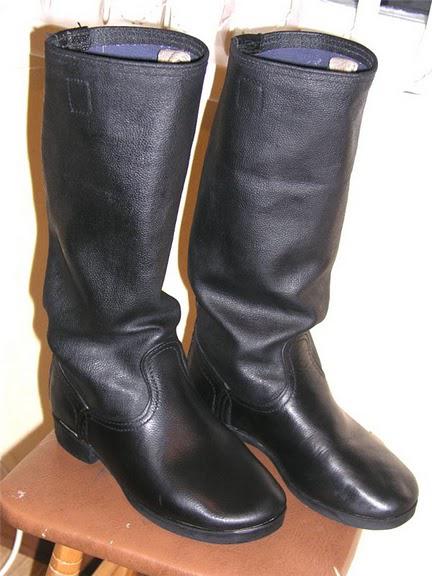
Source:
This article attempts to look over the Soviet and post-Soviet period of Russian history and choose the things that at one time had the greatest impact on life, worldview, health and other aspects of the lives of ordinary people.
Will the desire - add!

1. PRIMUS:
"And set fire to me, Arivederchi ...»
The Soviet people adored hiking.
Almost every second family just could not imagine vacation without kayaking, skiing, or at worst only the heavy backpack. And the most essential thing in the campaign - the primus.
Such an modified kerosene stove, on which you can boil tea, and fish fry. The most popular series was considered "Bumblebee" in various versions.
However, there is a version that the Primus was developed by Soviet scientists during the "cold war" as a weapon of mass destruction. In support of this assertion evidenced, for example, the movie "The Rock", in which the villains are thrown into the sewers some gizmo, painfully reminiscent of the native "Bumblebee-2", with the words: "Well, grohnet same now!" And indeed crashed - a little not shown.
Joking aside, but it was the primus, for example, the cause of death of the famous Hotel Elbrus "Shelter eleven."
Drunk Hungarian guest tried to pour fuel into the burning unit, and a few hours from the lodge was only a skeleton.
So our "Bumblebee" has earned a reputation Herostratian.

2. Boilers:
"Otvoari sly gate ...»
A relative of my friend in some hairy years went on trips abroad.
As his delegation had official and very high, all housed in a five-star London hotel. And in the evening after dinner, Russian delegate occurred to cook soup. Right in the room. From the bag, brought from the motherland. Without hesitation, comrade went tested by: went to the bathroom, poured into a sink of water, uncovered favorite boiler and put the plug into the socket. In the same second half of the pathos of the hotel remained without electricity: gourmet jams could not stand the pressure of the Soviet kilowatt unit.
Security sheikh stood on the ears, ran officers' Oh, I'm sorry for the inconvenience, do not even know how this could happen ... "In general, all the victims, including the perpetrators of the tragedy spread through other numbers. And for the hotel staff remained a mystery what happened with the proven power supply system.
And all because they did not know one simple truth: no Soviet citizen travels outside his city without a personal boiler.

3. "Spidola»:
"The enemy is on the line.»
Baltic States has always stood out among the republics of the USSR anti-communist sentiment polls. It was known to all.
But no one could have predicted that Lithuania will throw a big brother in the form of a pig "Spīdola."
The first Soviet portable transistor radio was made in 1961 at the Riga factory "WEF". And instantly became a cult object.
At relative compactness (not by today's standards, of course), he had a remarkable ability to catch waves. That is - the enemy's voice, "Voice of America", "Radio Liberty", "Deutsche Welle", etc. Suffice it to recall that in the epic "The fate of the resident" the main character - an American spy - namely with "Spīdola" takes encrypt their overseas owners.
Simple as Soviet people just getting infernal pleasure of listening to the restricted information through gebeshnye jammers.
So "Spidola" made a contribution to the destruction of the USSR. Legendary receiver is actually all products "VEF", turned out to be remarkably tenacious: my "Spidola," for example, is still regularly serves the country.
By the way, if someone does not know: the word "Spidola" to do the accent on the first syllable, not the second, as we have decided.

4. "Ribs»:
"The sound of bones do not ache.»
They say there was a time when the CD is not met even in science fiction stories.
Yugoslav vinyl too, it was not yet in sight.
But was Elvis Presley.
And everyone wanted to listen to him, but few could do it because of the terrible shortage of his records in the USSR. But necessity is the mother, as you know, the mother of invention.
Craftsmen whose names history, unfortunately not preserved, realized that conventional X-rays very well be used as a sound carrier. In film sound went the same way as a flexible phonograph.
Of course there were some inconveniences.
First, the sound extracted from such specific records, to put it mildly, different from the original - and not in a good way.
Secondly, a few confused design: a music library from another, pitted cirrhosis and Broken limbs - that, you know, a dubious pleasure. Nevertheless, the "edges" as popularly called rentgenplastinki, enjoyed great popularity, which is not surprising: the choice actually was not.
Snapshot recording disappeared only after release of the first reel to reel tape recorders.
But all the same, "the edges" made history as the Soviet symbol of the love of bourgeois culture.

5. "Varenko»:
"Denim soup.»
The heyday of perestroika took place in Russia under the banner of "Varenkov" as well as democracy prevails today under the tracksuits.
Why should fashion bleached jeans so tight puzzled our citizens - is unclear. We see too got all the ubiquitous trousers Avis, resembling the color of the school uniform. Very much wanted something festive and bright.
The technological process of the so-called "Varenkov" something like this: wet jeans while rubbed through several layers of hot rocks. As a result of the fact that until recently proudly called his pants, turned into a rag spotted indeterminate color.
And that, in the words of modern teenagers would have been cool.
First orient the private sector is still young.
In an instant, all the lumps were packed self-made jeans, jackets, shirts and caps fashionable colors.
One of our famous couturier even boasted recently that started her modeling career at "Varenkov." In it, darling, dressed schoolchildren, pensioners, engineers and racketeers.
Who does not have enough money for cooperative jeans, trying to make them at home. Someone frenziedly tore off with the same "Avis" paint "indigo" with pumice, some days cooked in boiling water pants (where, in fact, the generic name).
The fashion for "Varenko" stood firm for several years.
And now a no-no, but I run into the subway in some geezer, dressed in a work of domestic postmodernism.

"6. TV "KVN":
Home cinema. »
"In twenty years there will be no cinema, no theater, no books - only one television" - considered the hero of the film "Moscow Does Not Believe in Tears".
He, however, turned out to be a hero by definition negative and had to get a finger to the sky. But then, in the 50s, the first appearance of the Soviet Union certainly has guided many of the TV is on such thoughts.
Home theater, however, was far from perfect. For the small screen adjusts hefty magnifier to make the image more or less visible to the eye.
But the first "KVNy" caused, to put it mildly, a furor. Owning this miracle at first considered a sign of a relationship with a member of the Politburo, the highest recognition of any services to the Soviet government.
If this turned out to be a TV miraculously in a communal life happy owners turned into a living hell.
Every night they had to take a man forty neighbors, eager to enjoy some television program - and it does not matter what.
Today the idea of television has lost its appeal.
"KVN" was one of the symbols of familiarizing people's civilization.

7. GLUE "BF»:
"Do not glue and drink.»
This product is known for the fact that in recent history has been preserved evidence of its intended use.
No one can say exactly what they should be glued. Because "BF" is used quite differently.
His drinking.
That is, of course, not the glue, and what was left after special treatment.
Technology of preparation of alcoholic drinks from the highly technical to the liquid was simple madness. In a bottle of glue inserted electric and cut in the maximum speed. As a result, after a certain time all the adhesive basis is wound on a drill, and the liquid remained in the vessel.
Which could only be filtered to produce a relatively pure alcohol.
However, when the liquor store the day the fire will not find - there can be no purity. The highest popularity of "BP" reached, of course, during the "dry law».
They say that the audience is literally drinking on duty at hozmage, waiting will bring another batch of glue.
So "BF" became the first Soviet legalize drugs. 8. checks in "Birch:
"Vanity Fair. & Quot;
In one of the stories Dovlatov black marketeer Tallinn said about his henchman, saying that it will come with a hundred dollars in the store and take it immediately, because it is written on his face that he was not like a hundred dollars - three rubles spawn in the hands of I held.
Dollars in the Soviet Union did not go. Their role is performed by the so-called checks - equivalent to that exchange currency imported into the country.
Otovaritsya checks could only spetsmagazinah with the symbolic name "Birch".
Theoretically outfit in "Birch" could only foreigners and citizens save on foreign trips daily in. However, in practice checks could buy at a reasonable price anyone.
However, the proposal greatly exceeded demand. By "berezochnym" prices VCR - the ultimate dream of the average citizen - it costs about three thousand rubles at the salary of the chief engineer 300 p. per month.
So the bulk of the workers went to the foreign exchange shops only out of curiosity - to take a look at the stacks of canned Coca-Cola and refrigerators' Rosenlew. "
Legalization currency put "Birch" ending.
But the checks have remained a symbol of Soviet privilege.

9. ALCOHOL «Royal»:
"Hangover is not.»
If you are not familiar with this name - you are either too young or you're a staunch teetotaler.
Mean capitalists took us by surprise. It was the height of the economic reforms. Drink in the stores was terribly expensive, but the money was not enough at all.
And then he appeared.
As in the joke about the Red Army, which wiped with alcohol tank first signs of the formula, while others have tried and realized he really.
He was in a tempting green bottles.
And most importantly - when mixed with water 40-degree solution became cheaper domestic vodka three times.
Taste, of course, leaves much to be desired, but we were there to get used to - after the "BFA" - that! Dutch alcohol "Royal" was the more popular of the commercially available products, including butter and brown bread.
Vodka bought only snickering cooperators who was too lazy to mix alcohol with water. What he was drunk - do not tell anybody.
End crept unnoticed.
Suddenly it became clear that from the "Royal" people massively go blind due to an abundance of liquid methanol. People's solution became hopelessly withdraw from the sale.
Soon, the "Royal" has disappeared altogether. But the memory of it alive.
At least, I recently saw a familiar bottle on one retail market.
No way, hard times are coming ...
10. kirzachah:
"Spanish boot.»
Until 1917 boots were made in Russia only from the skin, and the word "tarpaulin" according to Dahl designated strain doors from dampness.
But the revolutionary government has recognized the luxury for the soldiers of the Red Army unprecedented extravagance.
Boots canvas upper (according to the TSB, is "tight, robust multilayer cotton fabric, produced from fine-spun yarns, treated with film-forming substance is used as a substitute for the skin") became a part of military uniforms in the 30s.
The find proved to be successful for the government.
For the poor it was finally found a replacement rounders, and that foot rub with great force, so tea is not a bar.
Popularity kirzachi compete with current jeans, good cost quite inexpensive.
In 30-40th tarpaulin became seriously and permanently possession students trade schools and prisoners, and in the post-war village was even the subject of boyish pride. Only in the early 60's popularity began to decline kirzachah.
However, in the Soviet Army is uncanny miracle lasted right up to the late 80's, extraordinarily raising the morale of the soldiers.
The latter, incidentally, is still referred to as the hated barley "tarpaulin».
via

Source:






